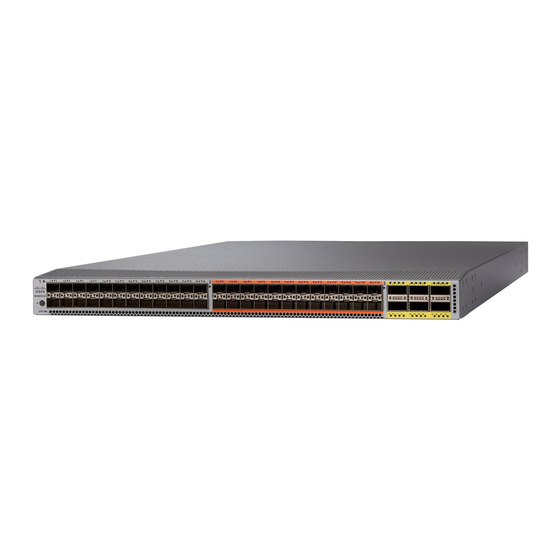
Cisco Nexus 5600 Series Manuals
Manuals and User Guides for Cisco Nexus 5600 Series. We have 3 Cisco Nexus 5600 Series manuals available for free PDF download: Reference, Configuration Manual, Hardware Installation Manual
Cisco Nexus 5600 Series Configuration Manual (378 pages)
NX-OS System Management
Table of Contents
-
C H a P T E
25 -
-
-
CFS Regions66
-
-
-
-
Chapter81
-
PTP Process83
-
-
Configuring RBAC100
-
-
C H a P T E
117 -
-
C H a P T E
163 -
Configuring DNS
167 -
Configuring SNMP
171-
Configuring SNMP176
-
Disabling SNMP189
-
Configuring SPAN
198-
SPAN Sources198
-
SPAN with ACL200
-
SPAN on Drop200
-
-
-
ERSPAN Types216
-
ERSPAN Sources217
-
Truncated ERSPAN218
-
ERSPAN with ACL218
-
-
-
-
Configuring NTP
241-
Configuring NTP244
-
Configuring EEM
257-
EEM Policies258
-
Configuring EEM262
-
-
Pipeline Support277
-
-
Netflow Overview283
-
Flow Record284
-
Flow Exporter284
-
Sampled Netflow287
-
-
Soft Reload
299 -
-
Snapshot309
-
Verifying GIR331
-
-
-
-
-
Overview of Smus356
-
-
Where to Go Next369
-
Advertisement
CISCO Nexus 5600 Series Reference (480 pages)
NX-OS Multicast Routing Command Reference
Brand: CISCO
|
Category: Network Router
|
Size: 3.22 MB
Table of Contents
Cisco Nexus 5600 Series Hardware Installation Manual (100 pages)
Table of Contents
-
Preface
7 -
-
-
Features15
-
Power Supply16
-
Fan Modules17
-
Transceivers18
-
-
-
Features18
-
Chassis20
-
-
N5600-M12Q21
-
-
Power Supply21
-
Fan Modules22
-
Transceivers23
-
-
-
Features23
-
Chassis24
-
-
N5600-M12Q24
-
-
Power Supply24
-
Fan Modules25
-
Transceivers26
-
-
-
Features26
-
Chassis27
-
-
N5696-M12Q28
-
N5696-M20Up29
-
-
N5696-M4C29
-
-
Ports
30-
Power Supply30
-
Fan Module31
-
Transceivers31
-
-
Features32
-
N56-M24Up2Q33
-
Power Supply33
-
Fan Modules34
-
Transceivers35
-
-
Features35
-
Power Supply36
-
Fan Modules37
-
Transceivers37
-
-
-
-
-
-
Appendix
67 -
Appendix
69 -
Appendix
75 -
Appendix
85 -
Leds
85 -
Appendix
89 -
Appendix
91 -
Appendix
95
Advertisement


